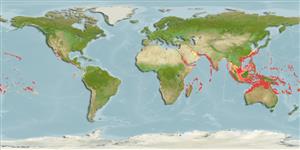Teleostei (teleosts) >
Anguilliformes (Eels and morays) >
Muraenidae (Moray eels) > Muraeninae
Etymology: Gymnothorax: Greek, gymnos = naked + Greek, thorax, -akos = breast (Ref. 45335).
More on author: Günther.
Environment: milieu / climate zone / depth range / distribution range
Ecology
Marine; reef-associated; depth range 2 - 271 m (Ref. 58302), usually 30 - ? m (Ref. 30404). Tropical; 20°C - 28°C (Ref. 130585); 30°N - 23°S
Indo-Pacific: Red Sea and Transkei, South Africa (Ref. 3257) to the Hawaiian and Marquesan islands, north to Ryukyu Islands, south to New Caledonia.
Size / Weight / Age
Maturity: Lm ? range ? - ? cm
Max length : 180 cm TL male/unsexed; (Ref. 9710)
Dorsal
spines
(total): 0;
Dorsal
soft rays
(total): 0;
Anal
spines: 0;
Anal
soft rays: 0. Large individuals; body dark yellow-brown numerous, smaller than pupil-sized spots that become small and numerous anteriorly, but large and widely spaced posteriorly (Ref. 48635). Yellow inside the mouth (Ref. 30404, 48635). This species has a relatively short, blunt snout; the larger specimens lack vomerine teeth and median intermaxillary teeth; the largest teeth are finely serrate; and jaws not arched, even in large specimens (Ref. 74922).
Mainly in oceanic locations (Ref. 48635). Adults are found inhabiting inner and outer reef slopes (Ref. 30404). Benthic (Ref. 58302). Mucus is toxic (Ref. 1602).
Life cycle and mating behavior
Maturity | Reproduction | Spawning | Eggs | Fecundity | Larvae
Chen, H.-M., K.-T. Shao and C.T. Chen, 1994. A review of the muraenid eels (Family Muraenidae) from Taiwan with descriptions of twelve new records. Zool. Stud. 33(1):44-64. (Ref. 6934)
IUCN Red List Status (Ref. 130435)
Threat to humans
Poisonous to eat (Ref. 1602)
Human uses
Fisheries: of no interest; aquarium: commercial
More information
Common namesSynonymsMetabolismPredatorsEcotoxicologyReproductionMaturitySpawningSpawning aggregationFecundityEggsEgg development
ReferencesAquacultureAquaculture profileStrainsGeneticsElectrophoresesHeritabilityDiseasesProcessingNutrientsMass conversion
Tools
Special reports
Download XML
Internet sources
Estimates based on models
Preferred temperature (Ref.
123201): 19.6 - 28.1, mean 26.1 °C (based on 626 cells).
Phylogenetic diversity index (Ref.
82804): PD
50 = 0.5000 [Uniqueness, from 0.5 = low to 2.0 = high].
Bayesian length-weight: a=0.00055 (0.00034 - 0.00088), b=3.29 (3.16 - 3.42), in cm total length, based on LWR estimates for this species & Genus-body shape (Ref.
93245).
Trophic level (Ref.
69278): 4.5 ±0.80 se; based on food items.
Resilience (Ref.
120179): Very Low, minimum population doubling time more than 14 years (Preliminary K or Fecundity.).
Fishing Vulnerability (Ref.
59153): Very high vulnerability (90 of 100).
